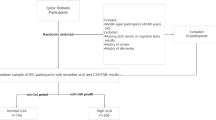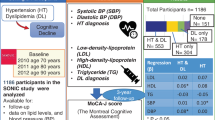Abstract
Contrasting evidence shows a possible association between serum uric acid (SUA) and cognitive function in elderly subjects. We aimed at evaluating the impact of circulating SUA levels on cognitive function in a cohort of pharmacologically untreated young elderly subjects. For this study, we selected 288 healthy young elderly participants from the historical cohort of the Brisighella Heart Study (M: 108, F: 180; mean age: 69 ± 6 years old). Exclusion criteria were limitation of activities of daily living, depression, chronic pharmacological treatment, patients in secondary prevention for cardiovascular disease, known neurodegenerative disorders, confirmed diabetes or gout, and ultrasonic evaluated carotid atherosclerosis. Cognitive functions were assessed by scholarship-adjusted mini-mental state examination (MMSE). A stepwise multiple regression analysis was carried out including a large set of clinical and laboratory parameters, carotid intima-media thickness, and the Beck Depression scale score. The analysis was then repeated by gender. In the multiple regression analysis, the only factors associated with the MMSE score were: age (B = −0.058, 95 % CI −0.108, −0.009, p = 0.022), LDL-C (B = −0.639, 95 % CI −0.912, −0.411, p = 0.034) and SUA (B = −0.527, 95 % CI −0.709, −0.344, p = 0.022). Repeating the analysis by low or high SUA level (based on the gender specific SUA distribution 50th percentile), it appears that in subjects with a low SUA, cognitive decline is only associated with age, while in those with high SUA it is associated with LDL-C (OR 1.18, 95 % CI 1.07–1.33, p = 0.019) and SBP (OR 1.02, 95 % CI 1.001–1.048, p = 0.039). Our data demonstrate a positive association between circulating levels of uric acid and cognitive dysfunction in a sample of pharmacologically untreated young elderly subjects.

Similar content being viewed by others
References
Hirtz D, Thurman DJ, Gwinn-Hardy K, Mohamed M, Chaudhuri AR, Zalutsky R (2007) How common are the “common” neurologic disorders? Neurology 68:326–337
Flirski M, Sobow T (2005) Biochemical markers and risk factors of Alzheimer’s disease. Curr Alzheimer Res 2:47–64. doi:10.2174/1567205052772704
Lahiri DK, Maloney B, Basha MR, Ge YW, Zawia NH (2007) How and when environmental agents and dietary factors affect the course of Alzheimer’s disease: the ‘LEARn’ model (latent early-life associated regulation) may explain the triggering of AD. Curr Alzheimer Res 4:219–228
Breteler MMB (2000) Vascular risk factors for Alzheimer disease. Neurobiol Aging 21:153–160
Christen Y (2000) Oxidative stress and Alzheimer disease. Am J Clin Nutr 71:621S–629S
Zhu X, Raina AK, Perry G, Smith MA (2004) Alzheimer’s disease: the two-hit hypothesis. Lancet Neurol 3:219–226
Anker SD, Doehner W, Rauchhaus M, Sharma R, Francis D, Knosalla C, Davos CH, Cicoira M, Shamim W, Kemp M, Segal R, Osterziel KJ, Leyva F, Hetzer R, Ponikowski P, Coats AJ (2003) Uric acid and survival in chronic heart failure: validation and application in metabolic, functional, and hemodynamic staging. Circulation 107:1991–1997. doi:10.1161/01.CIR.0000065637.10517.A0
Ruggiero C, Cherubini A, Ble A, Bos AJ, Maggio M, Dixit VD, Lauretani F, Bandinelli S, Senin U, Ferrucci L (2006) Uric acid and inflammatory markers. Eur Heart J 27:1174–1181. doi:10.1093/eurheartj/ehi879
Doehner W, Schoene N, Rauchhaus M, Leyva-Leon F, Pavitt DV, Reaveley DA, Schuler G, Coats AJ, Anker SD, Hambrecht R (2002) Effects of xanthine oxidase inhibition with allopurinol on endothelial function and peripheral blood flow in hyperuricemic patients with chronic heart failure. Circulation 105:2619–2624. doi:10.1161/01.CIR.0000017502.58595.ED
Johnson RJ, Rodriguez-Iturbe B, Kang DH, Feig DI, Herrera-Acosta J (2005) A unifying pathway for essential hypertension. Am J Hypertens 18:431–440
Ford ES, Li C, Cook S, Choi HK (2007) Serum concentrations of uric acid and the metabolic syndrome among US children and adolescents. Circulation 115:2526–2532
Johnson RJ, Kang DH, Feig D, Kivlighn S, Kanellis J, Watanabe S, Tuttle KR, Rodriguez-Iturbe B, Herrera-Acosta J, Mazzali M (2003) Is there a pathogenetic role for uric acid in hypertension and cardiovascular and renal disease? Hypertension 41:1183–1190. doi:10.1161/01.HYP.0000069700.62727.C5
Feig DI, Kang DH, Johnson RJ (2008) Uric acid and cardiovascular risk. N Engl J Med 359:1811–1821
Karagiannis A, Mikhailidis DP, Tziomalos K, Sileli M, Savvatianos S, Kakafika A, Gossios T, Krikis N, Moschou I, Xochellis M, Athyros VG (2007) Serum uric acid as an independent predictor of early death after acute stroke. Circ J 71:1120–1127
Schretlen DJ, Inscore AB, Jinnah HA, Rao V, Gordon B, Pearlson GD (2007) Serum uric acid and cognitive function in community-dwelling older adults. Neuropsychology 21(1):136–140
Schretlen DJ, Inscore AB, Vannorsdall TD, Kraut M, Pearlson GD, Gordon B, Jinnah HA (2007) Serum uric acid and brain ischemia in normal elderly adults. Neurology 69(14):1418–1423
Vannorsdall TD, Jinnah HA, Gordon B, Kraut M, Schretlen DJ (2008) Cerebral ischemia mediates the effect of serum uric acid on cognitive function. Stroke 39:3418–3420
Ruggiero C, Cherubini A, Lauretani B et al (2009) Uric acid and dementia in community-dwelling older persons. Dement Geriatr Cogn Disord 27:382–389
Afsar B, Elsurer R, Covic A, Johnson RJ, Kanbay M (2011) Relationship between uric acid and subtle cognitive dysfunction in chronic kidney disease. Am J Nephrol 34:49–54
Cicero AFG, Dormi A, D’Addato S, Borghi C, Brisighella Heart Study Staff (2011) From risk factor assessment to cardiovascular disease risk and mortality modification: the first 40 years of the Brisighella Heart Study. Clin Lipidol 6:269–276
Cicero AF, D’Addato S, Santi F, Ferroni A, Borghi C, Brisighella Heart Study (2012) Leisure-time physical activity and cardiovascular disease mortality: the Brisighella Heart Study. J Cardiovasc Med 13:559–564
Cicero AF, D’Addato S, Veronesi M, Rosticci M, Santi F, Dormi A, Borghi C, Brisighella Heart Study Group (2012) Relationship between blood pressure, cholesterolemia and serum apolipoprotein B in a large population sample: the Brisighella Heart Study. J Hypertens 30:492–496. doi:10.1097/HJH.0b013e32834f6b11
Levey AS, Stevens LA, Schmid CH, Zhang YL, Castro AF 3rd, Feldman HI, Kusek JW, Eggers P, Van Lente F, Greene T, Coresh J, CKD-EPI (Chronic Kidney Disease Epidemiology Collaboration) (2009) A new equation to estimate glomerular filtration rate. Ann Intern Med 150:604–612
Bonin-Guillaume S, Clément JP, Chassain AP, Léger JM (1995) Psychometric evaluation of depression in the elderly subject: which instruments? What are the future perspectives? Encephale 21:25–34
Simera I, Moher D, Hoey J, Schulz KF, Altman DG (2010) A catalogue of reporting guidelines for health research. Eur J Clin Invest 40:35–53
Folstein MF, Folstein SE, McHugh PR (1975) “Mini-mental state”: a practical method for grading the cognitive state of patients for the clinician. J Psychiatr Res 12:189–198
Crum RM, Anthony JC, Bassett SS, Folstein MF (1993) Population-based norms for the mini-mental state examination by age and educational level. JAMA 269:2386–2391
O’Bryant SE, Humphreys JD, Smith GE, Ivnik RJ, Graff-Radford NR, Petersen RC, Lucas JA (2008) Detecting dementia with the mini-mental state examination in highly educated individuals. Arch Neurol 65:963–967. doi:10.1001/archneur.65.7.963
Euser SM, Hofman A, Westendorp RG, Breteler MM (2009) Serum uric acid and cognitive function and dementia. Brain 132(Pt 2):377–382
Álvarez-Lario B, Macarrón-Vicente J (2010) Uric acid and evolution. Rheumatology 49:2010–2015
Wu Y, Zhang D, Pang Z, Jiang W, Wang S, Tan Q (2013) Association of serum uric acid level with muscle strength and cognitive function among Chinese aged 50–74 years. Geriatr Gerontol Int 13:672–677
Irizarry MC, Raman R, Schwarzschild MA, Becerra LM, Thomas RG, Peterson RC, Ascherio A, Aisen PS (2009) Plasma urate and progression of mild cognitive impairment. Neurodegener Dis 6(1–2):23–28. doi:10.1159/000170883
Kim TS, Pae CU, Yoon SJ, Jang WY, Lee NJ, Kim JJ, Lee SJ, Lee C, Paik IH, Lee CU (2006) Decreased plasma antioxidants in patients with Alzheimer’s disease. Int J Geriatr Psychiatry 21:344–348. doi:10.1002/gps.1469
Rinaldi P, Polidori MC, Metastasio A, Mariani E, Mattioli P, Cherubini A, Catani M, Cecchetti R, Senin U, Mecocci P (2003) Plasma antioxidants are similarly depleted in mild cognitive impairment and in Alzheimer’s disease. Neurobiol Aging 24:915–919. doi:10.1016/S0197-4580(03)00031-9
Polidori MC, Mattioli P, Aldred S, Cecchetti R, Stahl W, Griffiths H, Senin U, Sies H, Mecocci P (2004) Plasma antioxidant status, immunoglobulin G oxidation and lipid peroxidation in demented patients: relevance to Alzheimer disease and vascular dementia. Dement Geriatr Cogn Disord 18:265–270. doi:10.1159/000080027
Khanna D, Khanna PP, Fizgerald JD, American College of Rheumatology et al (2012) 2012 American College of Rheumatology guidelines for management of gout. Part 1: systematic non pharmacologic and pharmacologic therapeutic approaches to hyperuricemia. Arthritis Care Res 64:1447–1461
Yu MA, Sánchez-Lozada LG, Johnson RJ, Kang DH (2010) Oxidative stress with an activation of the renin-angiotensin system in human vascular endothelial cells as a novel mechanism of uric acid-induced endothelial dysfunction. J Hypertens 28:1234–1242
Vannorsdall TD, Jinnah HA, Gordon B, Kraut M, Schretlen DJ (2008) Cerebral ischemia mediates the effect of serum uric acid on cognitive function. Stroke 39(12):3418–3420
Verdecchia P, Schillaci G, Reboldi G, Santeusanio F, Porcellati C, Brunetti P (2000) Relation between serum uric acid and risk of cardiovascular disease in essential hypertension. The PIUMA study. Hypertension 36:1072–1078
Kodama S, Saito K, Yachi Y, Asumi M, Sugawara A, Totsuka K, Saito A, Sone H (2009) Association between serum uric acid and development of type 2 diabetes. Diabetes Care 32:1737–1742. doi:10.2337/dc09-0288
Gorelick PB, Scuteri A, Black SE, American Heart Association Stroke Council, Council on Epidemiology and Prevention, Council on Cardiovascular Nursing, Council on Cardiovascular Radiology and Intervention, and Council on Cardiovascular Surgery and Anesthesia. et al (2011) Vascular contributions to cognitive impairment and dementia. A statement for healthcare professionals from the American Heart Association/American Stroke Association. Stroke 42:2672–2713
Bos MJ, Koudstaal PJ, Hofman A, Witteman JC, Breteler MM (2006) Uric acid is a risk factor for myocardial infarction and stroke: the Rotterdam study. Stroke 37:1503–1507
Hozawa A, Folsom AR, Ibrahim H, Nieto FJ, Rosamond WD, Shahar E (2006) Serum uric acid and risk of ischemic stroke: the ARIC Study. Atherosclerosis 187:401–407
Verhaaren BF, Vernooij MW, Dehghan A, Vrooman HA, de Boer R, Hofman A, Witteman JC, Niessen WJ, Breteler MM, van der Lugt A, Ikram MA (2013) The relation of uric acid to brain atrophy and cognition: the Rotterdam Scan Study. Neuroepidemiology 41:29–34. doi:10.1159/000346606
Scuteri A, Nilsson PM, Tzourio C, Redon J, Laurent S (2011) Microvascular brain damage with aging and hypertension: pathophysiological consideration and clinical implications. J Hypertens 29:1469–1477
Bowman GL, Shannon J, Frei B, Kaye JA, Quinn JF (2010) Uric acid as a CNS antioxidant. J Alzheimers Dis 19:1331–1336
Shigemori K, Ohgi S, Okuyama E, Shimura T, Schneider E (2010) The factorial structure of the mini-mental state examination (MMSE) in Japanese dementia patients. BMC Geriatr 10:36. doi:10.1186/1471-2318-10-36
Tombaugh TN, McIntyre NJ (1992) The mini-mental state examination: a comprehensive review. JAGS 40:922–935
Wallace KL, Riedel AA, Joseph-Ridge N, Wortmann R (2004) Increasing prevalence of gout and hyperuricemia over 10 years among older adults in a managed care population. J Rheumatol 31:1582–1587
Trifirò G, Morabito P, Cavagna L, Ferrajolo C, Pecchioli S, Simonetti M, Bianchini E, Medea G, Cricelli C, Caputi AP, Mazzaglia G (2013) Epidemiology of gout and hyperuricaemia in Italy during the years 2005–2009: a nationwide population-based study. Ann Rheum Dis 72:694–700. doi:10.1136/annrheumdis-2011-201254
Acknowledgments
We are always grateful for the continuous and strong support by the Brisighella general practitioners, the Faenza public health district and the Brisighella municipality, without whom the whole Brisighella Heart Study would have been impossible to accomplish. The study was partly funded by the Fondazione del Monte di Bologna e Ravenna.
Conflict of interest
None.
Author information
Authors and Affiliations
Consortia
Corresponding author
Rights and permissions
About this article
Cite this article
Cicero, A.F.G., Desideri, G., Grossi, G. et al. Serum uric acid and impaired cognitive function in a cohort of healthy young elderly: data from the Brisighella Study. Intern Emerg Med 10, 25–31 (2015). https://doi.org/10.1007/s11739-014-1098-z
Received:
Accepted:
Published:
Issue Date:
DOI: https://doi.org/10.1007/s11739-014-1098-z




